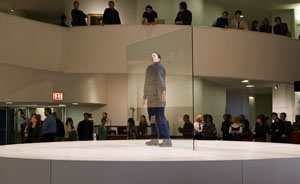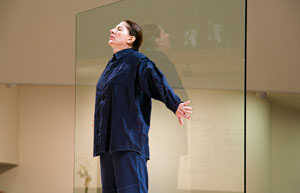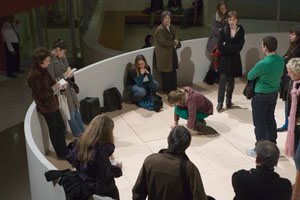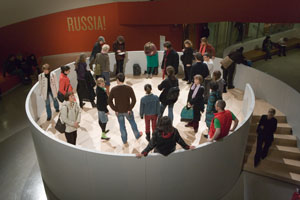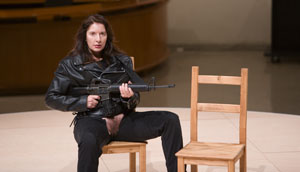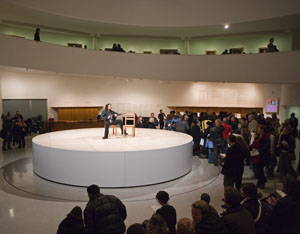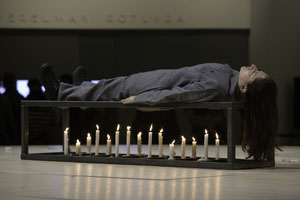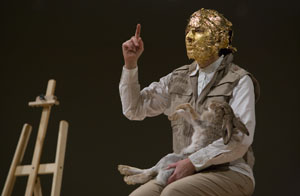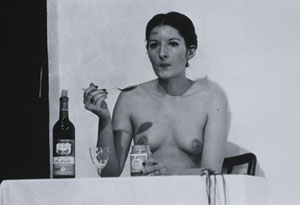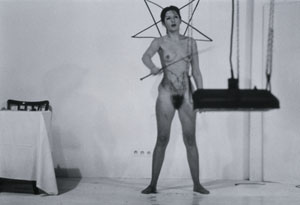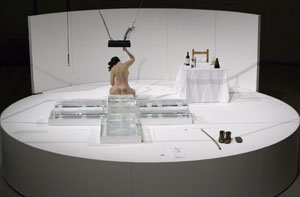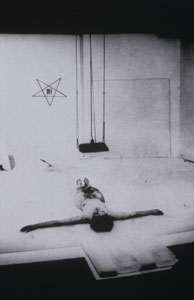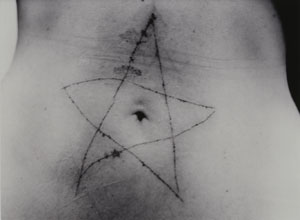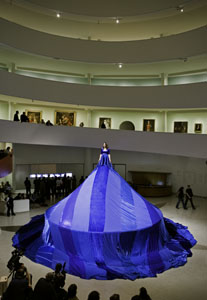For seven nights, starting on November 9, 2005, for seven hours each day, Marina Abramovic’s performance “Seven Easy Pieces” was held at the Guggenheim Museum. The event was part of the Performance Art Festival, which is led by the non-profit art organization “Performa” directed by RoseLee Goldberg. In this event, Marina Abramovic re-performed various artists’ historically significant performances.
In addition, Abramovic dedicated these performances to the late Susan Sontag, who had been her close friend.
First Night: Bruce Nauman, “Body Pressure” (premiered in 1974) Enlargement of the Symbolic and Imaginary World Which Changes the World
The first night kicked off the event with Bruce Nauman’s performance “Body Pressure,” first performed in 1974. This work is the most conceptual of the seven performances.
Marina Abramovic performing Bruce Nauman’s Body Pressure (1974) at the Solomon R. Guggenheim Museum on November 9, 2005.
Photograph by Kathryn Carr (c) The Solomon R. Guggenheim Foundation, New York.
With great force, Abramovic pushed her body to the glass on the stage, fixed at the center of the Guggenheim Museum, which suggested a wall. She repeated the act at approximately five-minute intervals for the seven-hour period from 5 p.m. to 12 p.m. Sweat soaked the shirt of Abramovic while performing the work.
Played repeatedly during the performance was an announcement recorded by Abramovic. This was a text written by Nauman in 1974, when he performed this piece:
Body Pressure
Press as much of the front surface of your body (palms in or out, left or right cheek) against the wall as possible.
Press very hard and concentrate.
Form an image of yourself (suppose you had just stepped forward) on the opposite side of the wall pressing back against the wall very hard.
Press very hard and concentrate on the image pressing very hard.
(the image of pressing very hard)
Press your front surface and back surface toward each other and begin to ignore or block the thickness of the wall. (remove the wall)
Think how various parts of your body press against the wall; which parts touch and which do not.
Consider the parts of your back which press against the wall; press hard and feel how the front and back of your body press together.
Concentrate on the tension in the muscles, pain where bones meet, fleshy deformations that occur under pressure; consider body hair, perspiration, odors (smells).
This may become a very erotic exercise.
Bruce Nauman, Body Pressure, 1974, (c) 2002 Bruce Nauman /Artists Rights Society (ARS), New York
Abramovic repeated this act with incredible concentration. She did not change any of her facial expressions on her serious face. Her serious attitude communicates her physical history as a performance artist.
This performance by Nauman seems like a challenge for physical “idea”-ness, as Plato suggests. Nauman did not choose a mirror, in which an image of the person appears as a reflection, but chose a wall: the artist cannot see the other side, and it does not reflect an image.
Jacques Lacan started his philosophy by dividing the world into the Imaginary, the Symbolic, and the Real, and he also defined the “mirror stage” of self-recognition as one in which the self is recognizing through the image that appears in a mirror as a reflection.
Nauman’s performance seems to trace a knot that holds together the Borromean Ring, connecting the Symbolic world (the sphere of unconscious, the world of symbols), the Imaginary world (in other words, the sphere of imaginary construction), and the Real world (practical things, or live experience). This knot, which constitutes the world, can be broken if one of these elements are cut. Nauman traced the different phases of these parts of the ring.
Before acquiring an M.A., Nauman studied mathematics and physics. The sentence, “Form an image of yourself on the opposite side of the wall pressing back against the wall very hard,” is mathematically correct. The reason why physical balance does not collapse when someone pushes against a wall is that the wall pushes back a pushing body with equal force.
Furthermore, Nauman tries to create the image of the act: “Press very hard and concentrate on the image pressing very hard” beyond the wall–that is, the image created is that of the act of pushing the body itself.
In other words, this sentence classifies existence into three categories: 1) “the pushing image = symbolic,” 2) “her own body beyond the wall = imaginary,” and 3) “the wall = the real.” Furthermore, the repetition of the performance enlarges the symbolic meaning of “pushing.”
Nauman tried to overcome the reality of the world, which is the existence of the wall, by inflating symbolic and imaginative parts through this performance. The sentence “begin to ignore or block the thickness of the wall (remove the wall)” dictates a serious attempt at such a radical act. Clearly, this performance represents a historically significant moment in performance art.
You may think this performance is nonsense. Yet the reason why currency flows is because the “symbol” of currency and the “imagination” of the expectation that everyone will use currency in the near future make it possible–there is no “real” (fundamental essence of the currency). Therefore, this performance is effective and relevant at present.
Marina Abramovic performing Bruce Nauman’s Body Pressure (1974) at the Solomon R. Guggenheim Museum on November 9, 2005.
Photograph by Kathryn Carr (c) The Solomon R. Guggenheim Foundation, New York.
While watching Abramovic’s performance pushing her body to the glass or the floor of a stage so earnestly over seven hours, I could not stop thinking about the historicity of her body. Her fatigue after several hours, her sweat: these are nothing but her own physicality.
Furthermore, there was the perception that a human body has become sharp. A novel sense of self, as I imagined the use of different body parts, was activated. When I heard a cell phone ring during the performance, this made me feel an awful sense of incongruity.
However, from certain curatorial poinst of view, some disappointing aspects remain. Since the performance was held in the Guggenheim Museum, a large museum, the performance used the glass. This allows members of the audience to see the performance from different angles. However, glass is not a “wall,” the “thing” that does not allow us to see the other side. Using glass, we can see through it. Because of this, the subject that Nauman originally targeted, which is the reality in front of you and the “imagination,” was changed. Some original intention of Nauman was not honored, and I had the impression that the work’s original radical-ness had faded away.
Second Night: Vito Acconci, “Seed Bed” (premiered in 1972) Imagination During Masturbation and Assumed Others
In his 1972 performance, Vito Acconci hid under a slanted surface installed on the floor of a gallery, watched the visitors to the gallery, and masturbated over the course of eight hours. He did this three times per week. Acconci spread his gasping voice through the gallery using a speaker, which the visitors of the gallery could hear. In Abramovic’s version, she performed the work at the Guggenheim Museum.
Marina Abramovic performing performing Vito Acconci’s Seedbed (1972) at the Solomon R. Guggenheim Museum on November 10, 2005.
Photograph by Kathryn Carr (c) The Solomon R. Guggenheim Foundation, New York.
In this performance, Abramovic hid under a circular stage and continually masturbated. The gasping voice that Abramovic creates covered the whole museum by menas of a large-size speaker. When I entered the museum, I was bewildered because the space was completely covered by the sound of the gasping voice. With the spread of Abramovic’s gasping voice, even the spiral exhibition space of Guggenheim Museum created a sexual feeling.
During the performance, Abramovic created a narration about her imagination. “Ohhhhh, yes, I love you…. Oh,o h, yes, I need you…. I need your permanent erection … uunn … ohh,” etc. When she reached the zenith of this feeling, she comes. After this, people thought that she would calm down for a while. She said, “Darling, I am tired, I am going to pee,” and urinated. We could hear the sound as well, and everyone in the audience smiled wryly. Within several minutes, she started masturbating again. For seven hours, in front of regularly 300 people in the space, the artist kept performing. I was surprised.
Marina Abramovic performing performing Vito Acconci’s Seedbed (1972) at the Solomon R. Guggenheim Museum on November 10, 2005.
Photograph by Kathryn Carr (c) The Solomon R. Guggenheim Foundation, New York.
However, it is difficult to masturbate without recalling another person. It is impossible to masturbate, even if the person is an extreme narcissist, if one is thinking of him/herself. In other words, even in masturbation, the act in which one brings oneself to climax, one needs to imagine another person. Acconci, masturbated while hiding and listning visitors to a gallery; but in Abramovic’s case, it is impossible to have interactive relations with the audience in this confined space in the large museum. As a result, the artist imagined another person and integrates the characteristics of him inside her, and continued her performance.
When watching this performance, I could not stop comparing it to the work of Sanja Ivekovic, who used masturbation in the context of the former Yugoslavia. Ivekovic masturbated on her the balcony of her Zagreb apartment on the day of a parade celebrating Tito, but when she did so, she got an order from a policeman to “remove the things in a balcony.” This performance of Ivekovic expresses the severe social criticism of a woman in the context of socialism.
Acconci created pseudo-private space by daringly masturbating in the gallery space (in other words, public space) where the act of masturbation act would be prohibited.. In case of Ivekovic, by taking advantage of the situation of women under the socialist regime, she sought to trace the outline of Socialism not by imitating a sniper, but by masturbating (this sexual act can be a weapon for women) in semi-public space (the balcony of her apartment) on the day of a parade for the President of a socialist country.
By the way, if a man performed this performance such as Ivekovic did, the meaning would be completely changed. When a woman performs it, it will evoke distinct social contexts: Ivekovic (a woman, less power, horizontal) and President (a man, power, vertical). (An anti-war demonstration made up of women without clothes might evoke similar contexts.)
In the work “Role Exchange” in 1975, Abramovic traded places with a prostitute in Amsterdam’s red-light district, and each completed the professional mission of each other (the artist = opening at the gallery; a prostitute = prostitution act). This is her answer as an artist for a gender issue. However, in this “seedbed” by Abramovic, both absurdity and sorrow, which come from women, performs this act, live together.
Furthermore, in this performance by Abramovic, I felt in terms of symbolism that the meaning that Marina Abramovic is performing is stronger than when the piece was performed by Vito Acconci, therefore the mythical character of Abramovic appeared more significantly. It can be said that Marina Abramovic is successfully in making herself mythical as a performer, and this is the best state of performance artists.
Third Night: Varie Export, “Action Pants; Genital Panic” (premiered in 1969) Women in Public Space and the Relationship of To See / To Be Seen
The performance “Action Pants,” which Varie Export performed in 1969, was a performance held during erotic film screening. Export walked through an art movie with crotchless pants and said “what you watch here is a reality.” In this re-performance, Abramovic interpreted this performance daringly.
Marina Abramovic performing VALIE EXPORT’s Action Pants: Genital Panic (1969) at the Solomon R. Guggenheim Museum on November 11, 2005.
Photograph by Kathryn Carr (c) The Solomon R. Guggenheim Foundation, New York.
When you enter the museum, Abramovic, wearing a leather jacket and black jeans and holding a machine gun, is sitting on the chair at the center of the stage, and stares at the spectators. The athletic Abramovic carrying a machine gun gives off a powerful impression, but a part of a crotch of the black jeans which she wears is completely removed. Her pubic hair and sexual organs were visible. The eyes of the audiences were naturally drawn to her crotch.
Holding a machine gun, Abramovic stared at the spectators with surprising concentration, earnestly and rarely blinking, for seven hours. She does not just gaze in the direction of the spectators, but stared at each spectator’s eyes at random. People stared at by Abramovic could not stand the excessive pressure, and almost everyone flinched away from her staring. Abramovic sometimes stood or sat down, and repeated the performance.
After waited for a while, my turn came. Abramovic glared at me. I glared back at her eyes, too. I could feel one of my neck muscles become stiff. I was glared at by Abramovic, and it made me quite tense. It lasted for approximately 30 seconds, and I kept on being tense. Also I was not able to look at her crotches while and after I was glared at.
Marina Abramovic performing VALIE EXPORT’s Action Pants: Genital Panic (1969) at the Solomon R. Guggenheim Museum on November 11, 2005.
Photograph by Kathryn Carr (c) The Solomon R. Guggenheim Foundation, New York.
It is natural that in front of a woman wearing crotchless pants, almost everyone in the audience will watch her crotch. However, the audience who watches her will be watched by her, since machine gun-toting Abramovic continues to watching her audience. The machine gun is quite heavy, and when we think about observing a person who has a machine gun, the audiences find it difficult to look at her crotch. Also here is the element of the myth, such as the “fear” which Abramovic, as a strong woman, elicits.
In the movie “Saving Private Ryan,” Steven Spielberg posed the critical question of the idea of public space, by putting “private” in a battlefield, which is public space(in other words, private = personal?), by using language structure.
In the case of Abramovic, she seems to challenge a general idea of public-ness by exposing her sexual organs with machine gun in a U.S. art museum, a public space in the country that started the Iraq War. The prefix pri in Latin, which appears in words such as private, was a prefix that meant “lack,” and it had a negative meaning in the Hellenistic period. In period of Roman dominance, the vocabulary of Greek was shifted into Latin, but, in the symbolic world of Hebraism after the Roman period, the implication of this word seemed to turn gentle.
Hannah Arendt discussed the fragility of publicity formed by the existence of individuals, but Abramovic seems to challenge the notion of the fragility of publicity and personal relations. In this context, we can understand that this performance is dedicated to Susan Sontag.
Also as she continued “watching” the audience with her machine gun we all were “watched” by numerous museum guards at the same time, and it was interesting. Without these guards, it is difficult to complete this performance. It was Thomas Struth who put the focus on the people who gathered in the museum, but not works of art, to make art works, but Abramovic’s works of art about “watching” was easily inverted in a venue called a museum. Without her intending it, her private performance was saved by watchdogs in the public space.
Fourth Night:Gina Pane, “The Conditioning, first action of Self-Portrait(s)” (premiered in 1973)Doing a Beautiful Performance
In this performance, Abramovic lies on an iron bed heated by the fire of a candle, approximately 25cm.She bears the heat earnestly. Like the other performances, this performance continues for seven hours.
Marina Abramovic performing Gina Pane’s Conditioning, first action of Self-Portraits (1973) at the Solomon R. Guggenheim Museum on November 12, 2005.
Photograph by Kathryn Carr c The Solomon R. Guggenheim Foundation, New York.
There is an interval of approximately 10cm between the fire and the iron bed, and although I could not tell visually whether she is hot or not, sometimes she moaned, which made us believe that she is bearing a considerably high temperature. About every one hour, she changed the candle, which had burned down, and again lay on the bed.
The impressive thing is that when she changed the candle, Abramovic fell off the bed with an enormous sound. Because of this enormous sound and unnatural way of falling, audiences became worried about her condition.
I was able to enjoy this performance visually, whereas other performances were considerably shocking. Abramovic, who lay on the bed horizontally by the flame, was nothing but beautiful.
Fifth Night: Joseph Beuys, “How to Explain Pictures to a Dead Hare” (1965) The Birth of New Myth – Civilization and Culture ?
This performance is probably the most difficult one to review in this whole re-performance series.
Abramovic wore a fisherman’s vest, a trademark of Beuys, her whole face covered in gold leaf, and walked around the stage while making a loud noise–“bash, bash”–by stamping an iron heel. On the stage, there was a chair, one leg of which is covered by felt, and some easels and black canvases, and a dead hare was prepared.
Marina Abramovic performing Joseph Bueys’s How to Explain Pictures to a Dead Hare (1965) at the Solomon R. Guggenheim Museum on November 13, 2005.
Photograph by Kathryn Carr (c) The Solomon R. Guggenheim Foundation, New York.
A dead rabbit was embraced in Abramovic’s hand peacefully, and the body of the rabbit was completely stretched as in rigor mortis. Abramovic, embracing a rabbit, sat down on a chair, and stretched her hand quietly, her forefinger pointing at the sky. Of course the hare is dead, and it cannot grasp the situation, but Abramovic continued whispering to the hare.
Embracing a hare on her left hand and supporting the hare’s hand by her forefinger, Abramovic moved in front of a blackboard, and moved the hare’s hand vertically. The behavior was very cute. Then, Abramovic bit the hare’s ear, and crawled around on the stage, so that the hare is running around the stage. The artist repeated the action many times; sometimes she lifted a cover on the stage, and stirred the hole with a stick. This was reminiscent of the birth of the archipelago in the Japanese Chronicle (Nihon Shoki), when the gods Izanaki and Izanami take down a pike in chaos and strum the tide slowly. From here, I am led to the conclusion that a performance is a creation of myth.
Joseph Beuys said that during World War II, when his fighter plane crashed in Crimea, Tartar people saved his life, and this experience influenced his own making. Beuys radically tried to define non-European culture as high culture, but unlike European culture which caused World War II. In other words, he tried to put civilization, which was recognized as a lower layer of culture, to a higher level than culture.
In German, the native language of Beuys, Kultur (culture = Bunka in Japanese) and Zivilisation (civilization = Bunmei in Japanese) have totally different meanings, and a German-speaking person clearly recognizes Kultur as a higher layer, and Zivilisation as a lower layer. In this point, it can be said that a German speaker has a different way of thinking from French speakers or English speakers who do not clearly distinguish these two words.
Because the parents of Abramovic were heroes of anti-Nazi partisans, it may be said that they were antagonists of Beuys during World War II. Through her practices with Tibetan lama and Australian aborigines, Abramovic understands enough about the significance of Zivilisation. The situation of a crossover between two artists trying to overcome European modernism is exciting.
It was Zhuangzi who thought of chaos as a place of origin, and he is mathematically right. Perhaps “chaos” in an Asian sense belonged to Zivilization (chaos = konton in Japanese), but not Kultur (in other words, chaos in European sense), which can be captured in German. It seems necessary to place a performance of Beuys as an extension of the European consideration of nature. A myth called performance occurred as a reaction to the distortion caused by the stiffness of monotheistic belief. Originally, this performance of Beuys must have been weird. However, this performance acquired too much publicity, and even became pop (such as in the chanting religious dance by Ippen), and the original creepiness was gone. However, this is not a failure of re-performance, but a result of re-performance after a few decades.
By talking to dead hare again and again, Abramovic tried to create a myth of overcoming the impossibility of conversation with the dead, but in the environment of too many noisy spectators in Guggenheim Museum it was impossible to make this performance divine. Because of these surroundings, it was difficult to concentrate on the performance. The sound of the iron attached to her heel hitting the floor is supposed to have a symbolic meaning, of sending a vowel into space, spreading an effect of Zivilization, but this sound was erased by a ringtone of a mobile telephone, which is too Kultur. Again, this is a tragedy of re-performance. Therefore, ironically, the situation emerges that a photo-recording of a performance has a more divine aura than the performance itself. The photograph which captures the moment of gold leaf on her face must be beautiful. However, even the video recording of Beuys’ performance seems more dramatic than his performance itself; this is a tragedy of information caused by the difference in medium.
Sixth Night:Marina Abramovic, “Lips of Thomas” (premiered in 1975) Fate of an Artist Born Under a Red Star and the Tragedy of the Slavs
The sixth night saw the re-performance of Abramovic’s legendary 1975 performance “Lips of Thomas” in Innsbruck, Austria, just after she just left Yugoslavia. In this performance, we can see that she carried the history of Yugoslavia on her back.
Marina Abramovic
Performance still from Lips of Thomas, 1975.
Performance, Galerie Krinzinger, Innsbruck.
Photo courtesy of the artist and Sean Kelly Gallery, New York.
c 2005 Artists Rights Society (ARS), NY/VG Bild-Kunst, Bonn.
Exactly at 5:00 p.m., Abramovic appeared on the stage nude, then sat down on a chair for a while, and switched on a metronome. We can only hear the sound of the metronome, tick-tock, echoing slowly into space. Ten minutes later, Abramovic opened a one-liter bottle of honey, which she started to eat slowly by putting a spoon in and out of the bottle. Her licking the spoon many times was especially sexual.
After eating honey for approximately ten minutes, the artist opened a wine bottle, and drank it slowly while staring in the direction of a spectator. Then, she picked up a razor on the table, and cut her stomach slowly and carefully, by tracing the outline of a star that was already written on her stomach. Meanwhile, a sound of a metronome counts the passing time slowly.
Blood dripped from her stomach slowly. Abramovic wore old combat boots placed on the stage, after having wiped up the blood with a white napkin, and put on an army cap, and picked up a stick. A red star was placed on this army cap, and the stick which curved slightly gave me an impression that the stick was like a Kalashnikov gun. (Abramovic herself told me that the shoes and the stick were originally used for the performance “The Lovers – Great Wall Walk” in 1988, and after the performance, the length of the stick shortened 15cm. The cap is from her mother which she wore during the Serbs’ partisan war against Nazi Germany.)
After Abramovic stood rigidly for a while, a Russian song sung by a female voice was played from a speaker. The song was a quite sad folk song that sang about history of Slavic tragedy.
The surprising thing is that as soon as this song was played, Abramovic started to weep very bitterly. The situation of a nude woman bleeding from the abdomen crying on the stage, was quite bizarre.
After the song had finished, Abramovic took off her shoes, and lay on an ice bed, arranged in the shape of a cross. After five minutes on the ice bed, she began whipping her body, silently.
Basically, Abramovic repeated this performance for seven hours. Approximately three hours into the performance, after wiping the blood from the star-shaped cut, she opened the white handkerchief. Then, we could realize that this handkerchief has lines as on a flag, and she tied this line to the edge of the stick. When the Russian song was played, Abramovic lifted a stick, and waved the white handkerchief which is dyed by blood. Did she “surrender” to anything? In this point, Abramovic was not crying anymore, but even had a slight smile.
Around 11 p.m., Abramovic got up from the ice bed, and she began quivering. The quivering persisted. Because her body temperature had decreased, her body kept shaking. I could not look at her anymore. In the original performance in 1975, one of the spectators, who could not look at her anymore, jumped into and terminated a performance; this time, spectators were saying, “Please, please stop,” or “You do not have to do it more” again and again. However, Abramovic did not quit the performance.
Marina Abramovic
Performance still from Lips of Thomas, 1975.
Performance, Galerie Krinzinger, Innsbruck.
Photo courtesy of the artist and Sean Kelly Gallery, New York.
c 2005 Artists Rights Society (ARS), NY/VG Bild-Kunst, Bonn.
Marina Abramovic
performing Lips of Thomas (1975) at the Solomon R. Guggenheim Museum on November 14, 2005. Photograph by Kathryn Carr (c)
The Solomon R. Guggenheim Foundation, New York.
What on earth does this performance mean? It seems nonsense to interpret an artistic performance, but I will try to interpret this performance.
Both Marina Abramovic’s parents were heroes of anti-German partisan resistance, and also aides of Marshal Tito. In addition, on her mother’s side, her grandfather was an archbishop of Eastern Orthodox Church, and because of his refusal to integrate with Roman Catholicism, he was poisoned by the royal family. Marina Abramovic mentioned in her book that because of this, her mother joined the Communist Party. When she had this performance, the exhibition called “Russia!” was held at the Guggenheim museum, and after I saw this exhibition, I could see the influence of Rome in the Slavic nations.
For example, the naming the Russian emperor came from Caesar in Greek, which was an official language of the Byzantine Empire. The word Slav spread to the world through Greek, but when the Greek-speaking area was taken by Byzantine Empire, defeated Slavic people were subordinated as slaves, and because of this history, the word slave, which comes from the name of Slavic peoples, appears in English. This historical context was directly imported into Latin, and afterwards it remained in English.
In the nineteenth century the Spring of Nations caused an upsurge of nationalism. Pan-Slavism emerged following the Russian Revolution, which is connected to the creation of Yugoslavia, meaning Land of the South Slavs. However, after the fall of communism, the country fell into civil war, which led to an aerial bombardment by NATO, which was created to fight against the Communist bloc.
Marina Abramovic
Performance still from Lips of Thomas, 1975.
Performance, Galerie Krinzinger, Innsbruck.
Photo courtesy of the artist and Sean Kelly Gallery, New York.
c 2005 Artists Rights Society (ARS), NY/VG Bild-Kunst, Bonn.
Abramovic’s act of whipping her own body can be regarded as an expression, almost a scream of her who had carried national ressentiment as a slave in history. To make the cross, which is a symbol of Eastern Orthodox Church, in ice calls to mind Russia, is inextricably linked to the history of all Slavic nations.
The Russian song directly describes the tragedy of Slavic nations, which is a history of war, and also the corruption of Yugoslavia. First of all, the killing of her grandfather and her mother’s entrance to the Communist Party, and moreover the exile to Western Europe the corruption of Yugoslavia from its outside is itself directly connected to the tragedy of Yugoslavia. (The difference of Serbs and Croats is a difference of religion?the Eastern Orthodox Church vs. the Roman Catholic Church– and it is the biggest reason for the corruption of Yugoslavia.)
Marina Abramovic
Performance still from Lips of Thomas, 1975.
Performance, Galerie Krinzinger, Innsbruck.
Photo courtesy of the artist and Sean Kelly Gallery, New York.
c 2005 Artists Rights Society (ARS), NY/VG Bild-Kunst, Bonn.
The reason why Abramovic dedicated this performance to Susan Sontag is that Abramovic respects Sontag’s entire personality and multicultural point of view, and the artist wished her presence when she performed this pieces. Furthermore, Abramovic respected her activity, such as Sontag’s staging of Beckett’s Waiting for Godot in Sarajevo during the war.Abramovic created her artistic expression about the same incident, the civil war in Yugoslav. When she was in her mother’s stomach, Marina Abramovic was already destined to be born under the name of communism. She cut her abdomen with a razor and drew a Red Star with own blood; raised a white surrender flag dyed with her own blood which was shaped as a Red Star in her own stomach in a performance in the U.S.A., the suzerain country of NATO–Marina Abramovic herself, who carried the history of Yugoslavia on its back, is a female national symbol such as Marianne or Britannica.
Furthermore, listening to the Russian song brought me a feeling of loneliness. Those sensitive to a distortion of the social system often leave their own mother country, since they are thinking too critically about it. When Zhang Huan did some performance criticizing China, he made performances of self-torture. Marina Abramovic has done the same.
Abramovic, who left because of cultural and political reason (Abramovic wanted to influence the culture outside of Yugoslavia), does not have her mother country anymore. The distance between Abramovic, who wore army cap atop a naked body and looked straight at the audience, and the audience, which is just the reality of American society, was remarkable, and also interesting.
In addition, unlike with the Beuys performance the day before the audiences who watched the performance did not make any noise that was especially impressive. In this performance, by setting up a wall which limited the perspective of the audience, the performer made it easier to create a more divine situation. In addition, the unusual situation of the naked performer doing this performance helped to make a more divine atmosphere. In this performance, I can say that Abramovic had been able to divinize herself.
When the performance was finished at midnight, the museum was wrapped in thunderous applause. It was impressive that there were many women who shed tears. As a person who shared this time for seven hours, I was also impressed and tears almost fell down my face.
Seventh Night: Marina Abramovic, “Entering the Other Side” (premiered in 2005) “You” and “I” are “Here”
The seventh night, the last day of the series of performances. At first, when I went into the museum, I was amazed by the huge installation. Abramovic, who wore a huge dress (which reminded me of Yohji Yamamoto’s three-meter dress), was on a stage placed at the center of the Guggenheim Museum, and looked around. This is a brand-new performance of hers, and probably this is the best work, at least from the point of view of using the Guggenheim’s unique space.
Marina Abramovic performing Entering the Other Side (2005) at the Solomon R. Guggenheim Museum on November 15, 2005.
Photograph by Kathryn Carr (c) The Solomon R. Guggenheim Foundation, New York.
The huge dress had stripes of different blue colors, which were beautiful. Abramovic, placed at the top of the dress, opened both hands wide, and was turning the upper part of her body, and looked around earnestly in every direction. This act had an impressive power, and when she turned her hands toward the ground, it was as if recalling something from the spirit of the earth. In addition, when she stretched her hands to the upper side, it was as if pursuing the meaning of praying, which cannot be consumed as an experience.
In the current symbolized world, virtually everything may become an object of consumption. If a job of a critic is to tell something by in language that is not symbolized, one of the jobs of performance artist is to create an act of “prayer” which is not symbolized or consumed. The performance can be created as a myth.
The act of praying seems meaningless at a glance, but to “pray” is to perform a sincere act in which people expend power for something unreachable, and impossible. To expend energy for something irreplaceable, that is the value of prayer.
A sigh of Abramovic, who opened her hands like a bird, was picked by microphone, and amplified quietly in the museum. The documentary film “Nanamui” by Toyomitsu Higa captured the image of women in Miyako-jima Islands in Okinawa who are over 50 years old go to a shrine in a mountain and play, sing and dance for gods. In the end, they behaved like birds and flew into sky. In Abramovic’s performance, the style is different, but may have some similarities relating to female physical characteristics. In other words, there might be a special reaction that only female bodies older than certain age can feel.
At 11:55 p.m., just before the end of performance, Abramovic whispered.
Please close your eyes, please.
Then, she continued.
Imagine.
I am here, and now.
You are here, and now.
There is no time.
You are here, and also I am here and spending time together is something miraculous. A distortion of time and space is gravity, and we are sharing that world and living together.
The structures of cult religions and contemporary art are somehow similar, and at this point, we need to be critical. Thus, I think that this new performance work is not the thing that I can evaluate blindly. It may be said that the performance is beautiful, such as the masterpiece artworks created in the 1960s, but there is no situation to receive this work in the present age. This is very disappointing, but it suggests that it may be important to make something completely new in our contemporary society.
After this performance was over, endless applause ensued. Abramovic, who had changed, clothes started to embrace each one of the staff, and then with the spectators, of whom I was one. That friendliness shows a lot about her character.
So, ”I am here now, and you are here now.” That is it.
(C)Copyright Shinya Watanabe
Shinya Watanabe is a member of the National Press Association in the United States.







